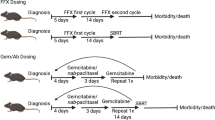Abstract
Gemcitabine is a promising new agent that has been recently studied for palliation of advanced (stage IV) unresectable pancreatic cancer. We hypothesized that adjuvant gemcitabine would reduce recurrence and metastases following surgical resection of pancreatic cancer. To test this hypothesis, we evaluated gemcitabine on a green fluorescent protein (GFP) transductant of the human pancreatic cancer cell line BxPC-3 (BxPC-3-GFP) using surgical orthotopic implantation (SOI) in nude mice. GFP enabled high resolution fluorescent visualization of primary and metastatic growth. Five weeks after SOI, the mice were randomized into three groups: Group I received exploratory laparotomy only. Group II underwent surgical resection of the pancreatic tumor without further treatment. Group III underwent tumor resection followed by adjuvant treatment with gemcitabine, 100 mg/kg every three days for a total of four doses, starting two days after resection. The mice were sacrificed at thirteen weeks following implantation and the presence and location of recurrent tumor was recorded. Gemcitabine reduced the recurrence rate to 28.6% compared to 70.6% with resection only (P=0.02) and reduced metastatic events 58% in the adjuvant group compared to resection only. This study, demonstrating that gemcitabine is effective as adjuvant chemotherapy post-pancreatectomy, suggests this new indication of the drug clinically.
Similar content being viewed by others
References
Greenlee RT, Murray T, Bolden S et al. Cancer Statistics, 2000. CA Cancer J Clin 2000; 50: 7–33.
Burris HA, MooreMJ, Andersen J et al. Improvements in survival and clinical benefit with gemcitabine as first-line therapy for patients with advanced pancreas cancer: a randomized trial. J Clin Oncol 1997; 15: 2403–13.
Bouvet M, Gamagami RA, Gilpin EA et al. Factors influencing survival after resection for periampullary neoplasms. Am J Surg 2000; 180: 13–7.
Gastrointestinal Tumor Study Group. Further evidence of effective adjuvant combined radiation and chemotherapy following curative resection of pancreatic cancer. Cancer 1987; 59: 2006–10.
Yeo CJ, Abrams RA, Grochow LB et al. Pancreaticoduodenectomy for pancreatic adenocarcinoma: postoperative adjuvant chemoradiation improves survival. Ann Surg 1997; 225: 621–33.
Fu X, Guadagni F, Hoffman RM. A metastatic nude-mouse model of human pancreatic cancer constructed orthotopically from histologically-intact patient specimens. Proc Natl Acad Sci USA 1992; 89: 5645–49.
Furukawa T, Kubota T, Watanabe M et al. A novel 'patient-like' treatment model of human pancreatic cancer constructed using orthotopic transplantation of histologically-intact human tumor-tissue in nude mice. Cancer Res 1993; 53: 3070–2.
An Z, Wang X, Kubota T et al. A clinical nude mouse metastatic model for highly malignant human pancreatic cancer. Anticancer Res 1996; 16: 627–32.
Tomikawa M, Kubota T, Matsuzaki SW et al. Mitomycin C and cisplatin increase survival in a human pancreatic cancer metastatic model. Anticancer Res 1997; 17: 3623–5.
Chishima T, Miyagi Y, Wang X et al. Cancer invasion and micrometastasis visualized in live tissue by green fluorescent protein expression. Cancer Res 1997; 57: 2042–7.
Chishima T, Miyagi Y, Wang X et al. Metastatic patterns of lung cancer visualized live and in process by green fluorescent protein expression. Clin Exp Metastasis 1997; 15: 547–52.
Chishima T, Miyagi Y, Wang X et al. Visualization of the metastatic process by green fluorescent protein expression. Anticancer Res 1997; 17: 2377–84.
Chishima T, Miyagi Y, Li L et al. Use of histoculture and green fluorescent protein to visualize tumor-cell host-tissue interaction. In Vitro Cell Dev Biol Anim 1997; 33: 745–7.
Chishima T, Yang M, Miyagi Y et al. Governing step of metastasis visualized in vitro. Proc Natl Acad Sci USA 1997; 94: 11573–6.
Yang M, Hasegawa S, Jiang P et al. Widespread skeletal metastatic potential of human lung cancer revealed by green fluorescent protein expression. Cancer Res 1998; 58: 4217–21.
Yang M, Jiang P, Sun FX et al. A fluorescent orthotopic bone metastasis model of human prostate cancer. Cancer Res 1999; 59: 781–6.
Yang M, Jiang P, An Z et al. Genetically fluorescent melanoma bone and organ metastasis models. Clin Cancer Res 1999; 5: 3549–59.
Yang M, Baranov E, Jiang P et al. Whole-body optical imaging of green fluorescent protein-expressing tumors and metastases. Proc Natl Acad Sci USA 2000: 97: 1206–11.
Bruns CJ, Solorzano CC, Harbison MT et al. Blockade of the epidermal growth factor receptor signaling by a novel tyrosine kinase inhibitor leads to apoptosis of endothelial cells and therapy of human pancreatic carcinoma. Cancer Res 2000; 60: 2926–35.
Bruns CJ, Harbison MT, Davis DW et al. Epidermal growth factor receptor blockade with C225 plus gemcitabine results in regression of human pancreatic carcinoma growing orthotopically in nude mice by antiangiogenic mechanisms. Clin. Cancer Res 2000; 6: 1936–48.
Author information
Authors and Affiliations
Rights and permissions
About this article
Cite this article
Lee, N.C., Bouvet, M., Nardin, S. et al. Antimetastatic efficacy of adjuvant gemcitabine in a pancreatic cancer orthotopic model. Clin Exp Metastasis 18, 379–384 (2000). https://doi.org/10.1023/A:1010831823004
Issue Date:
DOI: https://doi.org/10.1023/A:1010831823004




